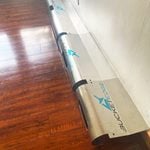Prevent peeling paint with water repellent preservative
How do you prevent peeling paint?

Peeling often begins with a tiny crack in the paint. A little water sneaks in and the wood swells, stretching the paint and causing more cracks. Then, as the water evaporates, it pushes against the paint from behind. Each time this cycle occurs, the crack grows and the paint bond weakens. It doesn’t take long before a minor crack becomes major peeling.
WRP prevents this cycle. Applied to bare wood before priming and painting, it keeps wood from absorbing water after the paint cracks. And that delays peeling. It’s just that simple.
Finding the right WRP isn’t so simple because some are paintable and some aren’t. The labels don’t always tell you, and the store employees won’t have any idea what you’re talking about. So I contacted a few manufacturers, talked to the guys in lab coats and found some widely available WRPs that are paintable. Here’s a list:
Cuprinol Clear Deck & Wood Seal: cuprinol.com
Olympic Clear Wood Preservative: olympic.com
Penofin Blue Label: penofin.com
Weatherscreen Clear Wood Preservative (available at Menard’s stores)
Woodlife Classic: wolman.com
Woodlife CopperCoat: wolman.com
— Gary Wentz, Senior Editor
.
Check out these painting articles from The Family Handyman:
– Painting Preparation: Making Paint Last, Prepare the Surface
– Trim Painting Tips


